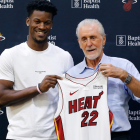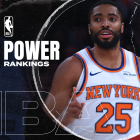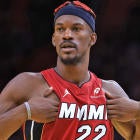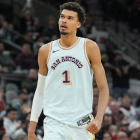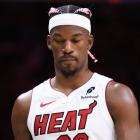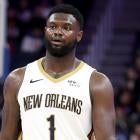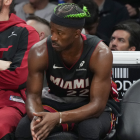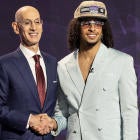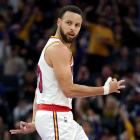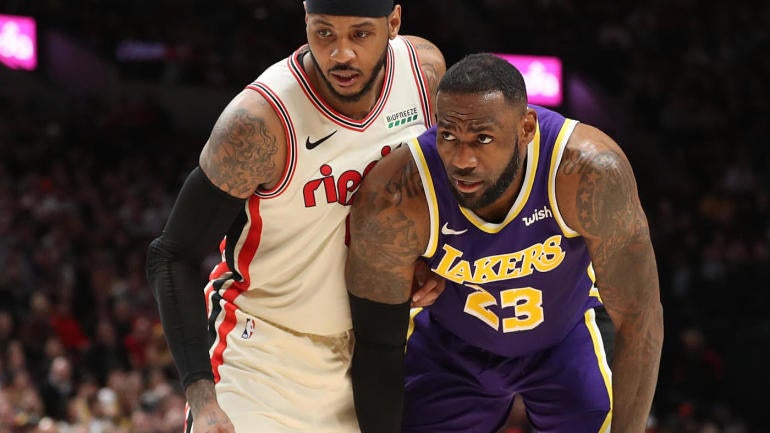
Los Angeles Lakers guard Alex Caruso drifted to the left corner, knowing an opportunity might be on the way. LeBron James hadn't caught the ball yet, but had sealed a smaller defender in the post. When James got it, Caruso slinked to the right, staying behind the 3-point line. The pass was perfect, and the shot was pure.
This was nine months ago, a run-of-the-mill connection between superstar and role player in a forgettable two-point win over an inferior opponent. In the third quarter, though, they connected again: James in the post, Caruso cutting through the Sacramento Kings' defense for an easy layup. They did the exact same thing on the next possession, and on the one after that James passed out of the post to Caruso for a 3 just like the one he'd hit in the first.
Caruso's chemistry with James is well documented, and the 26-year-old guard loves when James operates on the block. His passing simplifies the game for everyone, generating open shots and creating "easy offense," as Caruso put it on Monday, the day before the Lakers open their first-round playoff series against the Portland Trail Blazers.
"It puts teams in a troubling position because they have to determine what they want to do," Caruso said. "If they leave him one-on-one on an island, he can easily go and score, and score a lot. And if they go double-team him, he's the best passer in the game, so he's going to find the open man."
All of Caruso's made shots in that Sacramento game came off of James' post-ups. Caruso sat out when the Lakers played the Kings in their final seeding game last week, as did Anthony Davis, Kentavious Caldwell-Pope and Kyle Kuzma. On the opening possession, James went to the post against 6-foot-3 guard Cory Joseph, drew a double-team and created a wide-open corner 3, but rookie Talen Horton-Tucker missed it.
The Lakers' halfcourt offense is their most glaring big-picture concern, and it has been awful in the bubble. James kept posting up in that Sacramento game, though, and they scored 40 points in the first quarter, the most they managed in any quarter in Orlando. James only played 15 minutes and finished with 17 points on 6-for-13 shooting, plus four assists.
What do you think of that, Russ?
Seeing James dominate down low is normal now, but it didn't used to be. He grew up playing the point, and remained most comfortable making plays from the perimeter as he developed into the league's best player. It was only after he joined the Miami Heat and lost to the Dallas Mavericks in the 2011 NBA Finals, the eighth season of his career, that he decided he needed big-man skills in his arsenal. He told Heat coach Erik Spoelstra that he would spend his offseason, which would be extended by a collective-bargaining dispute, working on his post game.
"When he returned after the lockout, he was a totally different player," Spoelstra told Kirk Goldsberry in a 2013 Grantland story. "It was as if he downloaded a program with all of Olajuwon's and Ewing's post-up moves. I don't know if I've seen a player improve that much in a specific area in one offseason. His improvement in that area alone transformed our offense to a championship level in 2012."
On the first night of free agency in 2018, James met with then-Lakers president Magic Johnson. They talked for more than three hours, and, according to ESPN's Brian Windhorst and Ramona Shelburne, they pitched him on a radically different role than the one he'd been playing: If he signed with the Lakers, they'd surround him with playmakers, so he wouldn't have to create everything himself. He could be more of a finisher, and, like plenty of aging stars before him he'd spend more time in the post.
That didn't work, and when they traded almost everyone on the roster for Davis, James became not just the de facto point guard but the nominal one. But the post-up part of the plan has come to fruition under coach Frank Vogel. This season, the 35-year-old James used a total of 323 possessions on post-ups (including assists), which ranks sixth in the league, and his average of 4.8 post-up possessions per game is his highest mark since leaving Miami six years ago, according to Synergy Sports.
Only eight players, per Synergy, had more than 300 post-ups, and James generated 1.102 points per possession on his, a higher mark than everyone except Joel Embiid and Nikola Jokic. By way of contrast, his close friend and first-round foe Carmelo Anthony posted up one fewer time, but only generated 0.913 points per possession. Giannis Antetokounmpo, the likely back-to-back MVP, posted up 11 fewer times than James and generated 0.984 points per possession. For context: The Golden State Warriors' league-worst offense scored 1.044 points per possession.
James is the Lakers' quarterback. He controls their offense from the perimeter, and Vogel likes to position him at the elbow to facilitate. Putting him in the post is "just one of our many offensive weapons," Vogel said, and they wield it selectively.
On March 1 in New Orleans, they trailed by two points against Zion Williamson's Pelicans heading into the fourth quarter. James proceeded to take over the game from the post against the overmatched Josh Hart and Jrue Holiday:
James had 13 points and three assists in the quarter and finished with a 34 points, 13 assists and 12 rebounds with Davis (and Caruso) sidelined. Los Angeles won 122-114, a reminder that, if Los Angeles is in a tough spot, it can call on James to exert his will.
Depending on how the Blazers approach the defensive end, we could see a lot more of this starting on Tuesday. Portland's defense was a complete mess in the seeding games, and the Lakers could choose to attack it multiple ways. It is not difficult, however, to find examples of James using his size to bully a Blazer in the regular season. He usually got a bucket, a foul or an open look for a teammate out of it:
There are variables here. The Lakers haven't played the version of this team that starts Anthony, Zach Collins and Jusuf Nurkic in the frontcourt. Vogel could choose to shift Davis to center to start Game 1 instead of waiting to make the seemingly inevitable adjustment. Anthony and Collins are theoretically large enough to guard James, but would Portland coach Terry Stotts really leave either of them to defend James one-on-one? Gary Trent Jr. has often guarded the opposing team's best wing player, but at 6-5 and 209 pounds he'd be bulldozed.
Regardless of the defensive assignments, Stotts will surely stress sprinting back in transition and avoiding crossmatches. If James ends up with Damian Lillard or CJ McCollum on him, game over.
"He's one of the best in probably the history of the game at reading the double-team from that spot," Vogel said. "And obviously if you don't double him he's going to punish you at the rim."
As the Philadelphia 76ers showed us on Monday, playing out of the post is harder than it sounds. Few players do it because entry passes are tough, help defense is sophisticated and only the very best are able to see the whole court, make quick reads and create high-percentage shots from that vantage point. James is the exception to lots of rules, though, and, if the Blazers can't steer him elsewhere, he'll eat them alive.
Previously on That's Pretty Interesting: Joel Embiid's Sixers can't beat Celtics if they do everything the hard way









